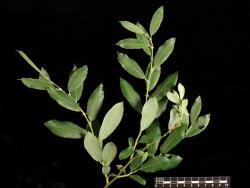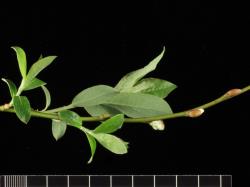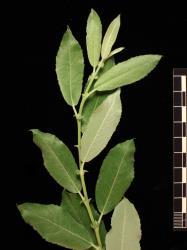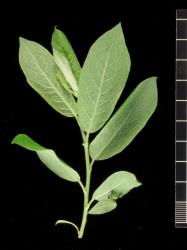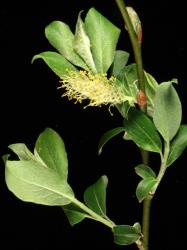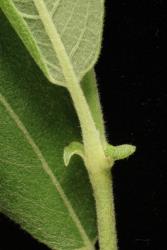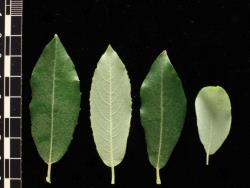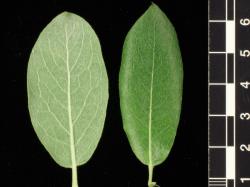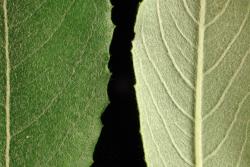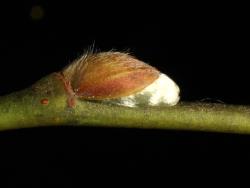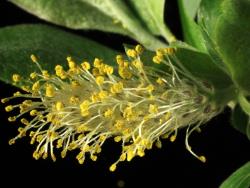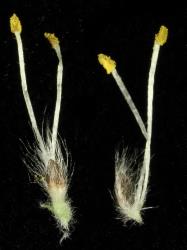- = Salix cantabrica Rech.f., Österr. Bot. Z. 109: 374–376 (1962)
Current year's branchlets densely tomentose, hairs not persisting, green. Flower buds 5.5 mm long, 3.8 mm wide, 3.1 mm deep, ovoid, with two angles, light olive, moderately dense long-silky hairy. Leaves alternate. Stipule 4 mm long, asymmetrically narrowly ovate, with an auricle at the base, hairy, persistent. Petiole 7–8 mm long, densely tomentose on all sides, groove absent, glands absent, base not expanded, pale green. Emerging leaves green, with densely short-silky hairs. Proximal leaves entire. Leaf lamina 48–60 mm long, 24–26 mm wide, length to width ratio 1.8–2.5:1, elliptical to narrowly elliptical or obovate; base rounded to truncate, not falcate; apex obtuse to acuminate; leaf galls absent; margins of young leaves entire, mature leaves sparsely to moderately densely serrulate, finely revolute, undulate; upper lamina surface very slightly bullate due to impressed veins, dull, moderately densely short-silky hairy, stomata absent; lower lamina surface midvein and side-veins raised, netted veins visible, surface distinctly glaucous, moderately densely short-silky hairy. Catkins male, opening simultaneously with leaves. Flowering branch 32 mm long, with 5 reduced leaves. Male catkin 25 mm long, 7 mm diameter; catkin rachis not visible between flowers. Flower bract 2.3 mm long, brown in the upper half, flat and slightly curved inwards on long axis; apex rounded to acute, dense long-silky hairy. Male nectary 1, 0.8 mm long, 0.32 mm wide, yellow. Stamens 2, filaments free, filament hairs present at base; anthers 0.8 mm long, yellow.
Young shoots are densely tomentose but the hairs do not persist. Leaves are narrowly elliptical to obovate, the margins undulate, sparsely serrate, and finely revolute; there are short-silky hairs on both surfaces, and the lower surface is glaucous. Stipules are 4 mm long, asymmetrically narrowly ovate, hairy, and persistent. Leafy buds are hairy. The flower bract is brown in the upper half. Anthers are yellow.
Skvortsov (1999) compared this species with Salix phylicifolia L. It differs in having dense hairs on the young leaves and stems (glabrous or very soon lost in S. phylicifolia), bracts brown (black in S. phylicifolia) and veins to the third order on the leaf underside are prominent (only second-order veins are prominent in S. phylicifolia). Palmerston North plants have the features of S. basaltica, not S. phylicifolia.
Grown at Aokautere, PN712 was sent to New Zealand by J. M. Chmelar, Czechoslovakia, in 1979 as S. cantabrica, "ex Spain, Pyrénée". Not known from elsewhere in New Zealand.
First collection: CHR 644672, L. Newstrom-Lloyd, M.Garbarret, B. Polturat, 12 December 2014, Aokautere.
First publication: This publication.
Flowering: Early December.
No chromosome counts are published, but flow cytometry of PN712 provisionally indicates it is tetraploid.
New Zealand material was accessioned to the National Willow Collection as Salix cantabrica. Skvortsov (1999) says "S. cantabrica Rech.f. was described from the Cantabrian Mountains (north Spain). Since the description was based on a single specimen it remains dubious. Most probably, it is nothing other than S. basaltica".



